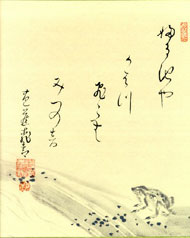 |
||
| Probably the most well-known haiku is Basho’s poem about a frog and a pond. See Rexroth’s translation at right or 31 translations on the Bureau of Public Secrets or Chad Sweeny’s 33 translations. | ||
My first encounter with haiku was one rule: 3 phrases of 5, 7, 5 syllables respectively. Later I learned about the “cut” line, where the poet uses punctuation such as a dash to divide the poem into two juxtaposing or contrasting parts. As I read more about haiku in both Japanese and contemporary English and began writing my own, I gave up on the first rule — “syllable” isn’t quite what the Japanese form uses and some haiku enthusiasts say 11 syllables and a 3-5-3 syllable meter is closest to the quality of the Japanese form while others prefer the sort of “free form” haiku that I write (there’s a nice explanation of this here by Keiko Imaoka.) Some of Kenneth Rexroth’s translations of famous Japanese haiku use a free form style:
Autumn evening —
A crow on a bare branch.An old pond —
The sound
Of a diving frog.
So probably I don’t write haiku at all, but something called “micro poetry” (see this article on Jim Murdock’s blog about short form poetry ) — but I’ll continue to be entraced by inventing 2 images in 3 lines.

There are many forms of micropoetry, though the genre cannot be defined or limited to any of these. There’s haiku, gogyohka, tanka, senryu, twaiku. The definition of Micropoetry is a genre of poetic verse which is characterized by its extreme brevity. So to put it bluntly, a micropoem is just a short poem.
I just launched a website, PS SMS The Poet Society of Social Media and SMS. It invites poets to submit any kind of poem, as long as it’s 160 characters or less. But it also encourages people interested in discovering new types.
Would love for you to have a look
http://pssms.com/
^_^